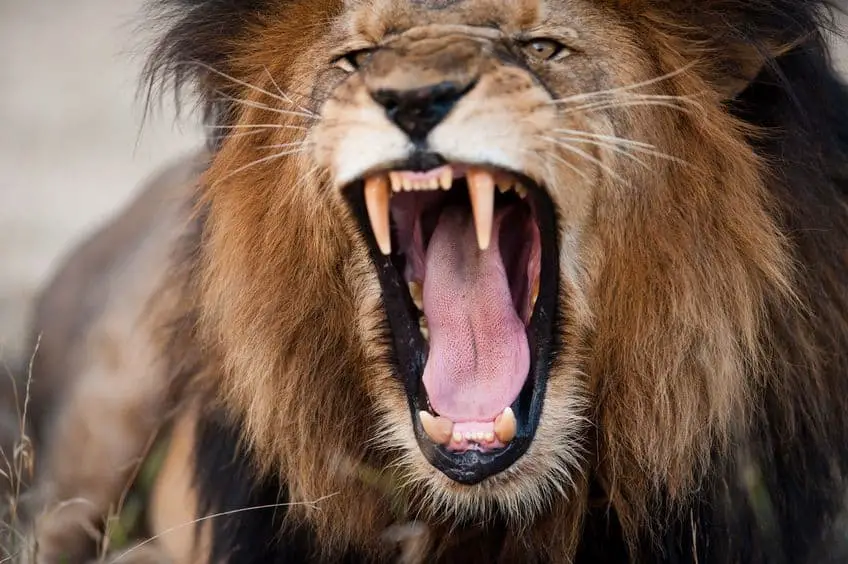
Perhaps the most iconic and well-known of all African animals, lions are truly majestic and powerful creatures and there are so many fascinating, exciting, mesmerizing, and fun facts about them that you should know so I have collected 64 of the most interesting and surprising facts about lions in this post.
Facts About Lions’ Behavior
- Lions sleep upwards of 20 hours per day and are often seen resting or sleeping in the shadow of a tree or some bushes. (Read more).
- Male lions usually sleep more than females. The reason for this is that the females generally spend more time hunting and taking care of cubs.
- Lions prefer to rest near waterholes. Especially on warm, sunny days where they need easy access to water.
- Lions are considered to be nocturnal but many sources also categorize them as crepuscular. This means that they are active primarily in the twilight period which is the time period between dawn and sunrise or between sunset and dusk. (Read more).
- One of the primary reasons why lions sleep as much as they do is to optimize the preservation of energy for the night as they need it for hunting.
Facts About Lion Distribution And Habitat
- Lions can be seen in most of sub-Saharan Africa.
- The largest populations of lions are found in South Africa, Botswana, Kenya, Tanzania, Zambia, and Zimbabwe.
- Lions have often been referred to as the king of the jungle but lions do not actually live in jungles.
- Lions can live in many types of habitats including savanna, grassland, forest, shrubland, and desert.
Facts About Lions’ Social Structure
- Lions are social creatures that mostly stay together in groups.
- A group of lions is called a pride.
- A pride of lions can consist of anywhere between 3-40 lions. The largest prides are usually found in the eastern parts of Africa for instance in Kenya and Tanzania.
- A pride of lions is made up of a large group of females that are usually all related to each other, their cubs, and a small group of males.
- When male lions reach the age of 2-4, they leave their pride and become nomads until they are large and strong enough to claim a territory and a female pride of their own.
- Female lions stay in the pride they were born in for their entire lives.
- The female lions in a pride stick together for their entire lives. The males come and go every couple of years.
- The lionesses are the primary hunters in a pride. Male lions will generally only hunt if they have to.
- Lions are highly territorial animals. A female pride can keep the same territory for decades and many generations.
Facts About Lions’ Life Cycle And Offspring
- The lifespan of lions in the wild is 16 years for the males and 18 years for the females. The lifespan of lions in captivity is 30 years.
- The average life expectancy of lions in the wild is 12 years for the males and 15 years for the females.
- The gestation period of female lions is 3.5-4 months.
- Lionesses usually give birth to 1-4 cubs but sometimes up to 6.
- Lion cubs weigh 2-4 pounds (1-2 kg) at birth.
- Female lions raise and take care of the cubs with help from the other females in their pride. The males generally do not help much with raising the cubs.
- Lion cubs drink milk from their mother for the first 6-7 months of their lives since it is full of nutrients that will help them grow and become strong.
- Lion cubs will begin to add meat to their diet after around 2-3 months.
- At the age of 6-7 months, lion cubs’ diet will consist of meat just like the fully grown lions.
Facts About Lions’ Hunting Style And Diet
- Lions are large and heavy cats that cannot run fast for a long period of time so they have to make their kill fast. (Read more).
- Lions usually hunt at night or in the very early morning or late evening.
- Lions rely on stealth and their ability to sneak up on animals when they hunt since much of their usual prey animals can actually run faster than the lions. This is also one of the reasons, why hunting at night is so beneficial for lions since most of their preferred prey is resting or sleeping.
- Lions burn excessive amounts of energy when they run and hunt so by hunting when it is dark, they preserve much more energy since it is colder and since most of their preferred prey are not active at night and are therefore easier to hunt.
- On rare occasions, lions can be seen hunting during the day. They will almost only do so if the weather is cloudy or cold since warm and sunny weather is too energy-consuming for them.
- Lions have excellent eyesight in low-light conditions which gives them a big advantage over their prey.
- Male lions make sure that they get to eat first and will usually not let anybody near the food before they are full.
- If a pride of lions has killed a large animal that contains plenty of food for the whole pride, the males will sometimes let the lionesses and the cubs eat right away.
- Lionesses almost always let the cubs eat first.
- Lions can sometimes go for 4-5 days without eating.
- Lions can consume food equal to 20% of their body weight. For the largest males, that means 110 pounds (50 kg) of food at the same time.
- In addition to hunting, lions often scavenge a large portion of their food. In some regions of Africa, upwards of 50% of lions’ food comes from scavenging. In other regions, only around 5-10% of their food comes from scavenging. (Read more).
- When lions hunt as a group, they can take down animals that are 10 times larger than themselves including hippos, rhinos, fully grown giraffes, and young elephants.
- When a pride of lions hunts together, they will often surround their target and then sneak up and attack from all directions to prevent the animal from escaping.
- Lions are not picky when it comes to eating. They can hunt and eat almost any animal ranging from small beetles and critters to large mammals such as Cape buffalos, giraffes, or even hippos, rhinos, and young elephants. (Read more).
- Despite being able to hunt and eat almost any animal, lions have their favorites and their diet usually consists of just a couple of different animals.
- What animals lions hunt and eat varies a lot from region to region and depends mostly on what animals are found in the lions’ territory.
- Lions prefer to hunt and eat medium-sized or large mammals such as zebras, wildebeest, Cape buffalos, oryxes, kudus, impalas, springboks, giraffes, and other similarly sized animals.
- Lions barely chew their food. Their teeth are designed for ripping flesh apart rather than for chewing so lions often swallow entire pieces of meat.
- Lions cannot digest plants. Their entire digestion system is built specifically for the digestion of meat and is missing some enzymes that are used for the digestion of plants.
Facts About Lions Appearance And Physical Traits
- Lions are the largest cats in Africa.
- Male lions are significantly larger than female lions.
- Female lions are the largest female cats in the world. Even larger than female Siberian tigers even though male Siberian tigers can get larger than male lions.
- Male lions weigh 330-600 lb (about 150-272 kg) and female lions weigh 265-400 lb (about 120-180 kg).
- One of the most characteristic and well-known physical traits for lions is the mane. Only male lions have manes.
- The size and color of a male lion’s mane vary throughout its life.
- The larger and darker a lion’s mane is, the more dominant the lion is.
- The size and color of a male lion’s mane are largely determined by the lion’s levels of testosterone. A lion with a large and dark mane has high levels of testosterone and is usually more aggressive than other lions.
Facts About Lion Conservation
- The conservation status of lions is vulnerable.
- There are estimated to be between 23,000-39,000 lions left in the wild in Africa.
General Facts About Lions
- Lions are members of The Big Five. A legendary group of large African animals that include lions, Cape buffalos, elephants, leopards, and black rhinoceros. (Read more).
- Lions belong to the Felidae family of animals, more commonly known as cats.
- The scientific name of lions is Panthera leo.
- Lions can run 50 mph (80 kph).
- Lions are apex predators which means that no other animals prey on them.
- Despite being apex predators, lions still have some (but few) natural enemies such as Cape buffalos and elephants. (Read more).
- Hyenas and crocodiles do not generally attack fully grown lions but they can sometimes try to kill lion cubs.
You can see all our posts about lions on this page.
